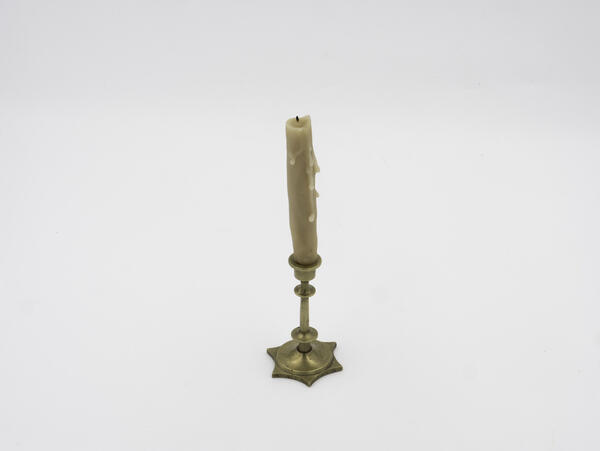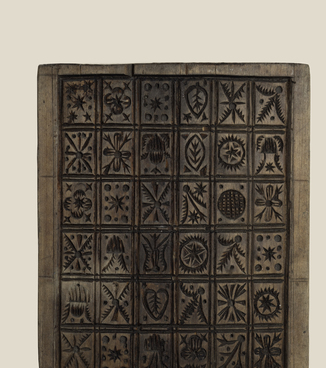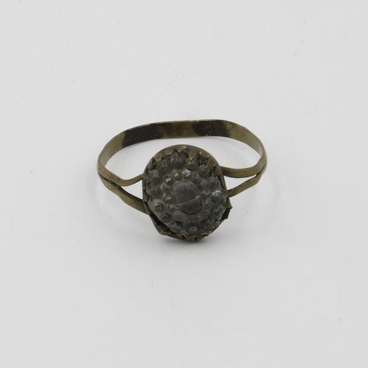At Christmastide, during the period from Christmas to Epiphany, it was customary to tell fortunes with the help of various objects — jewelry, clothing parts, mirrors, towels, tablecloths, and candles. They served as a magical intermediary between a person and the other world. Traditionally, fortune-telling was included in the list of magical actions of pagan worship, which was condemned or prohibited by the official church and secular authorities.
Most often, unmarried girls were engaged in divination at Christmastide. They told fortunes for the future betrothed, about getting married soon, about a happy married life. The fortune-telling kit presented in the museum collection has candlesticks, a plate, a mirror, and a ring. Using these objects, one could tell fortunes in different ways, but lit candles were always an important part of the ritual. Even in modern times, when electricity has become available to people, the tradition of telling fortunes exclusively by candlelight has been preserved.
One of the most popular ways to find out the future was to light a candle, which was passed around among friends. Whoever had it extinguished in her hands would be the first to get married. Also, girls told fortunes with two mirrors and candles between the mirrors: while the candles were burning, girls tried to see the image of their betrothed in the mirror. An interesting fact was that women started the rituals with their heads uncovered, without a headscarf, since in this case, the veil was a guarding obstacle that prevented communication with spirits. In fact, divination with mirrors or water replacing the mirror surface required great courage. The fortune-tellers appeared in front of the mirror in an undershirt without a cross. The mystical fear of this rite was explained by the fact that the mirror surface could take the soul of the fortune-teller forever, and the mirror frame or the well beam was associated with the door to the other world.
Often, candles were considered a magical object that could tell a lot to the fortune-teller. For example, in order to check whether the young people were compatible, they lit two candles and looked at the flame. If both candles burned evenly, without crackling and soot, it meant that relations in the family would be calm and stable. If one of the candles began to crackle or smoke — it was a sign that one of the partners would soon have a change of heart towards the other. In general, as the researchers point out, the use of candles, logs, fire, and a stove as a guardian of fire in divination is also explained by their semantic load: fire symbolizes the sun’s energy and indicates the desired goal — enrichment, fertility, and prosperity.
Another well-known method of fortune-telling with a candle also required the use of a plate with water. The candle was lit and one waited for the flame to melt the wax at the base of the wick. After that one took the candle in the left hand and tilted it over the water, observing what shapes the wax left on its surface.
In addition to candles, other divination objects were used: spinning wheels and spindles, handkerchiefs, various kinds of flowers, and herbs that were woven into a crown. Many of the divinations have survived to this day and become part of a fun ritual that modern girls resort to for entertainment.
Most often, unmarried girls were engaged in divination at Christmastide. They told fortunes for the future betrothed, about getting married soon, about a happy married life. The fortune-telling kit presented in the museum collection has candlesticks, a plate, a mirror, and a ring. Using these objects, one could tell fortunes in different ways, but lit candles were always an important part of the ritual. Even in modern times, when electricity has become available to people, the tradition of telling fortunes exclusively by candlelight has been preserved.
One of the most popular ways to find out the future was to light a candle, which was passed around among friends. Whoever had it extinguished in her hands would be the first to get married. Also, girls told fortunes with two mirrors and candles between the mirrors: while the candles were burning, girls tried to see the image of their betrothed in the mirror. An interesting fact was that women started the rituals with their heads uncovered, without a headscarf, since in this case, the veil was a guarding obstacle that prevented communication with spirits. In fact, divination with mirrors or water replacing the mirror surface required great courage. The fortune-tellers appeared in front of the mirror in an undershirt without a cross. The mystical fear of this rite was explained by the fact that the mirror surface could take the soul of the fortune-teller forever, and the mirror frame or the well beam was associated with the door to the other world.
Often, candles were considered a magical object that could tell a lot to the fortune-teller. For example, in order to check whether the young people were compatible, they lit two candles and looked at the flame. If both candles burned evenly, without crackling and soot, it meant that relations in the family would be calm and stable. If one of the candles began to crackle or smoke — it was a sign that one of the partners would soon have a change of heart towards the other. In general, as the researchers point out, the use of candles, logs, fire, and a stove as a guardian of fire in divination is also explained by their semantic load: fire symbolizes the sun’s energy and indicates the desired goal — enrichment, fertility, and prosperity.
Another well-known method of fortune-telling with a candle also required the use of a plate with water. The candle was lit and one waited for the flame to melt the wax at the base of the wick. After that one took the candle in the left hand and tilted it over the water, observing what shapes the wax left on its surface.
In addition to candles, other divination objects were used: spinning wheels and spindles, handkerchiefs, various kinds of flowers, and herbs that were woven into a crown. Many of the divinations have survived to this day and become part of a fun ritual that modern girls resort to for entertainment.



